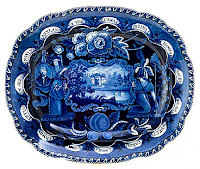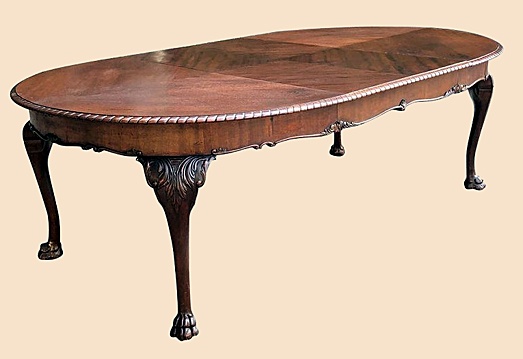QUESTION: Recently I bought a pair of chairs at an outdoor antique show that seem to have been made of rough-hewn logs and branches. The dealer said they came from the Adirondack Mountains in New York State. They’re well-built and with a couple of pillows on each are rather comfortable. What can you tell me about this style of chairs?
ANSWER: Your chairs are what’s known as rustic furniture, also known as Adirondack furniture, even though it wasn’t restricted to just the Adirondack Mountains.
 Rustic furniture is furniture made of sticks, twigs, or logs for a natural look. The term “rustic” came from the Latin “rusticus,” meaning “peasant”.
Rustic furniture is furniture made of sticks, twigs, or logs for a natural look. The term “rustic” came from the Latin “rusticus,” meaning “peasant”.
The idea for rustic furniture came about in the late 18th century at the beginning of the back-to-nature movement, a change from the world of classic, predictable furniture patterns to one of more fanciful design using natural materials.
Little summer shelters appeared in city gardens, often covered in vines or surrounded by trees and shrubs. These summerhouses also provided a small green refuge that shut out the discomfort and ugliness of city life.
Designers copied nature's lines in drawings for chairs and settees for these shelters and the garden paths around them. Their plans called for gnarled, distorted limbs of shrubs and trees to make a chair or bench, instead of the usual marble or plain wooden seats. Gardens, themselves, became more picturesque and less formal, with curving paths taking the place of straight ones. Designers strategically placed rustic chairs, benches, arbors and gates throughout the plantings.
The rustic furniture movement reached its peak during the mid- to late-19th century. In the 1870s, several American firms specialized in rustic furniture. Adirondack craftsmen produced high quality pieces for new woodland camps of wealthy New Yorkers. These included Camp Pine Knot, Kamp Kill Kare, Camp Uncas and Great Camp Sagamore. The National Park Service also adopted the style for its park lodges. The first and largest manufacturer of such furniture was Old Hickory Furniture Co., established in 1890.
 Although basic living conditions were the rule in the camps and cottages that sprung up in the mountains, the original coarse, primitive furniture evolved into fanciful and rustic as camp owners updated their amenities.
Although basic living conditions were the rule in the camps and cottages that sprung up in the mountains, the original coarse, primitive furniture evolved into fanciful and rustic as camp owners updated their amenities.
By the late 19th century, America’s millionaires filled these camp resorts, and although they considered themselves naturalists, they dressed and lived formally in the midst of the rustic furniture, for they had no intention of roughing it.
Some of these naturalists set up their own camps with tents and log cabins and built rustic furniture for them or had local craftsmen do it for them. Eventually, the log cabins became large log houses with all the latest amenities. Soon they became known as compounds or family camps.
 Typical pieces of rustic furniture included chairs, love seats, tables, desks, smoking stands, clocks, chest of drawers, rockers, coat racks, mirror frames, beds and lamps.
Typical pieces of rustic furniture included chairs, love seats, tables, desks, smoking stands, clocks, chest of drawers, rockers, coat racks, mirror frames, beds and lamps.
Rustic outdoor furniture filled the porches of these camp houses and spilled onto the grass. Couches and chairs made of rough pieces of local woods, holding loose cushions, adorned the sitting rooms. Even the beds showed off the rustic style, often with fanciful patterns on the head and foot boards.
 Rustic furniture had a functional style and was made of organic materials, such as the tree or shrub limbs and roots or the trunks of saplings indigenous to the area of the maker. Although roughly made, the style was often sophisticated and imaginative. The more knots there were in the limbs, the more the furniture makers favored them. They even left the bark on the wood whenever possible to give each piece more texture and individuality.
Rustic furniture had a functional style and was made of organic materials, such as the tree or shrub limbs and roots or the trunks of saplings indigenous to the area of the maker. Although roughly made, the style was often sophisticated and imaginative. The more knots there were in the limbs, the more the furniture makers favored them. They even left the bark on the wood whenever possible to give each piece more texture and individuality.
Many of the rustic styles reflected the personality of their maker, with techniques such as chip carving, silver or gold brushwork, milk paint, peeled bark and other decorative enhancements. But people often referred to some rustic furniture as primitive because it displayed a lack of craftsmanship.
 Furniture makers used two basic types of rustic-furniture construction—bentwood, for which they harvested fresh sticks or steamed them to make them supple, then bent into a variety of structures and decorative shapes and twig work, consisting of straight, curved, or forked sticks assembled into structures and decorative shapes within a structure. Sometimes, they employed both types in the same piece. Some rustic furniture makers also used mortice and tenon construction while others simply nailed or screwed pieces members together.
Furniture makers used two basic types of rustic-furniture construction—bentwood, for which they harvested fresh sticks or steamed them to make them supple, then bent into a variety of structures and decorative shapes and twig work, consisting of straight, curved, or forked sticks assembled into structures and decorative shapes within a structure. Sometimes, they employed both types in the same piece. Some rustic furniture makers also used mortice and tenon construction while others simply nailed or screwed pieces members together.
For their furniture, makers used many different woods, including willow, hickory, mountain laurel, and Alaska cedar. In the Deep South, some occasionally used palm fronds.
 Makers used large, gnarly roots in their furniture designs, making them into table legs and chair arms. To produce a striking veneer for their pieces, furniture makers preferred birch, a slender tree with bark that peeled in strips. These pieces quickly became known for their geometric designs made of the white birch bark veneer, especially on case furniture, such as chests and cabinets. Also, many of the intricate veneered designs included various kinds of split twigs, carefully chosen by color to form patterns.
Makers used large, gnarly roots in their furniture designs, making them into table legs and chair arms. To produce a striking veneer for their pieces, furniture makers preferred birch, a slender tree with bark that peeled in strips. These pieces quickly became known for their geometric designs made of the white birch bark veneer, especially on case furniture, such as chests and cabinets. Also, many of the intricate veneered designs included various kinds of split twigs, carefully chosen by color to form patterns.
Unlike their Adirondack counterparts, Appalachian furniture makers took pride in knowing how to get wood to work for the intricate twists, bends and weaving for their furniture designs. They knew just when and how to bend saplings while they were still growing, letting nature do some of the work before they were ready to use the wood. They preferred laurel, hickory, and willow because of their flexibility and strength. They built their furniture with graceful loops and interwoven curves, weaving each piece of wood to create tension, resulting in a hidden strength disguised by the fragile look of the design.
 Today, rustic pieces often appear at higher-end antique shows. Occasionally, they appear at flea markets. But people consigned a lot of pieces to the bonfire after they went out of fashion in the mid-20th century. So prices tend to be on the high side because of the uniqueness of the pieces. Twig rockers can sell for $150 and up, while lounges and settees can go over $2,000.
Today, rustic pieces often appear at higher-end antique shows. Occasionally, they appear at flea markets. But people consigned a lot of pieces to the bonfire after they went out of fashion in the mid-20th century. So prices tend to be on the high side because of the uniqueness of the pieces. Twig rockers can sell for $150 and up, while lounges and settees can go over $2,000.
Case pieces—chests and cabinets—rarely come on the market and when they do, their prices are exceptionally high, often in the four and five figure range. The most common pieces are various chairs and plant stands, priced anywhere from $75 to $600.
As the 20th century moved forward, individual craftsmen found it hard to keep up with the volume of orders, so factories opened to meet the need. Business remained brisk for the rural craftsmen until the 1940s and by the 1950s, rustic furniture was no longer popular.
To read more articles on antiques, please visit the Antiques Articles section of my Web site. And to stay up to the minute on antiques and collectibles, please join the over 30,000 readers by following my free online magazine, #TheAntiquesAlmanac. Learn more about the "The World of Art Nouveau" in the 2022 Spring Edition, online now. And to read daily posts about unique objects from the past and their histories, like the #Antiques and More Collection on Facebook.













































